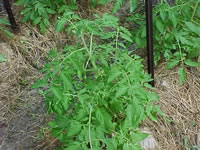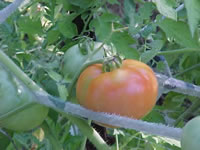|
If drainage may be an issue, you might want to consider growing your Tomatoes in a raised planting bed.
Raised beds warm up earlier in the spring and will ensure good drainage.
An actively growing Tomato plant needs about 2 gallons of water each week.
Water regularly and deeply after the weather begins to warm up, to keep the soil evenly moist, but never soggy.
Container grown plants may need more frequent watering.
Use care not to wet the foliage because that leads to a higher instance of both bacterial and fungal disease.
After the soil has warmed, apply a layer of mulch to control weeds and hold in heat and moisture.
Black plastic works well as a mulch for Tomatoes.
Apply a Tomato type fertilizer with an N-P-K ratio of 8-24-8 at planting time
and then begin regular applications as soon as fruit begins to form.
Always follow label directions closely for the best results.
Check plants regularly for diseased leaves or plant parts that appear diseased.
If disease is found, throw the entire plant into the trash.
Do not throw them in the compost pile!
After the growing season ends, remove all the Tomato plants from the garden and throw them in the trash.
Rotate crops yearly to help keep soil diseases from striking other members of the Tomato family.
Should Tomato Plants be Pinched?
Some people choose to pinch or deshoot the side shoots that emerge where the leaves join the main stem.
This will result in earlier and larger, but fewer Tomatoes on each vine.
By resisting the urge to pinch blindly, and only removing lower branches that touch the ground,
you will create a bushier plant with somewhat smaller but a more abundant harvest.
The additional foliage will serve to provide needed shading for the fruit from direct, hot sun to avoid sun scalding.
Methods of Growing Tomatoes
Tomato plants can be grown in pots or buckets, provided that they are large enough
(5 gallons or larger) and have very good drainage.
Use a quality potting soil mix that does not contain fertilizer unless you want more foliage than fruit!.
Tomatoes can be grown on trellises or up support stakes, in Tomato Cages
or they can be allowed to sprawl along the ground.
Staked plants take less garden space and are easier to work around.
Use a sturdy, six foot stake, set a foot deep in the ground at planting time.
Once the plant attains sufficient height, secure it loosely to the stake.
I recommend using a length of an old nylon stocking because it will stretch as the plant grows,
rather than cutting into the stem, as string will do.
Loop each tie into a figure 8, with the crossed portion between the stem and the support
to keep stems from rubbing or being choked. Add more ties as the stem grows.
Staked Tomatoes and those grown in cages can be planted 2 feet apart
in rows that are spaced 3-4 feet apart.
Many gardeners prefer to grow their Tomatoes in manufactured or home made Tomato cages.
Manufactured cages are made from stiff wire and may be square or round.
They are quick and easy to use but there are limited heights available and no way to extend them.
They can get expensive if you are growing a large crop. They also tend to be a bit flimsy.
If you are growing more than just a few plants, you can cage your tomatoes using different methods and materials.
The "Florida Weave" involves two rows of t-posts (or other sturdy posts) spaced 2 ft. apart.
Additional pairs of posts are added every 3 or 4 feet as needed.
Fasten heavy gauge wire to each post, 12" from the bottom.
When your Tomato plants are about 18" tall, weave heavy jute twine or string back and forth
between the wires so that each side of each plant is supported.
When you reach the end of the row, tie the twine off then reverse direction until each Tomato is woven in on all four sides.
Add a second wire half way up each post, and another wire about 12" from the top of the post.
After this point, you will be able to easily weave your twine horizontally, vertically or diagonally as needed to support your Tomatoes.
Field fencing is often used to make 'cut to order' Tomato cages.
If you choose to use field fence, make sure that you get a style that has
large enough holes that you can reach in and retreve your Tomatoes!
Always wear heavy leather gloves when working with field fence!
Many gardeners choose to just let their Tomato plants sprawl along the ground.
If you are using this method, you need to put down a heavy layer of seed-free grass clippings,
straw or dry leaves to help keep the plant and fruits from direct contact with the ground.
This will help prevent disease, keep dirt from splashing on the foliage
and will make it easier to control slugs, snails and other pests.
Tomato plants that are allowed to sprawl should be grown 3 ft. apart, in rows that are 4-5 feet apart.
Selecting the Right Tomato for your Garden
Indeterminate Tomatoes, the staking kinds, continue to vine and
produce fruit until they are killed back by frost.
They are capable of growing 8 ft. or more in a season.
Recommended types: "Beefmaster", "Better Boy", "Roma", "Sun Golsd"and "Sweet 100".
Determinate Tomato Plants are compact bush and dwarf types of Tomatoes.
They stop height growth when they reach their expected size,
shortly after the initial flush of fruit.
This type includes "Husky Gold", "Pixie", "Rutgers", "Razzleberry" and "Viva Italia".
Select disease resistant varieties of Tomato that are suited for local area.
A VFN notation indicates the Tomato hybrid is resistant to
Verticillium Wilt, Fusarium Wilt and Root Knot Nematodes.
You may also see additional letters affixed to the hybrid.
A T indicates resistance to Tobacco Mosaic Virus
A indicates a resistance to Alternaria alternata, Crown Wilt.
L indicates a resistance to Leaf Spot, Septoria.
St indicates a resistance to Stemphylium, Gray Leaf Spot.
Propagating Tomato Plants and Growing them from Seed
|
New Tomato plants can be propagated by using side shoots as cuttings.
Remove any flowers or buds, as well as the lower leaves.
Dip the cutting in rooting hormone,
and plant it directly in the garden in full sun, where it is to grow.
Strike the cutting deep enough that the top cluster of leaves is just above the soil line, but not in contact with the soil.
Cut off the bottom of a gallon milk jug, remove the cap,
and place it over the cutting to act as a greenhouse.
New roots will begin to form all along the buried stem within a week or so.
In areas with warm springs and long growing seasons, Tomato seeds can be sown directly
in the garden as soon as the danger of frost has passed.
Tomatoes will not grow at temperatures below 50°
so it pointless to plant them before the temperatures warm up.
|
|
Start Tomato seeds indoors 6-8 weeks before the last killing frost.
Sow Tomato seeds ¼" deep in trays or cell packs filled with potting soil.
Maintain a temperature in the growing medium of 70°-75° until germination, which takes 5-8 days.
When the plantlets reach the 2 or 3 leaf stage, they should be transplanted into 2" or 3" pots
and kept ia a warm, bright, well ventilated area until it is time to move them to the garden.
Plant Tomatoes two inches deeper than they were growing at previously!
A late, unexpected frost will destroy your Tomato crop, so for the first couple weeks after planting
you should keep some five gallon buckets, tenting material or hot caps handy to cover your Tomato plants in case the unthinkable happens!
Tomatoes
Lycopersicon esculentum
 |
 |
|


